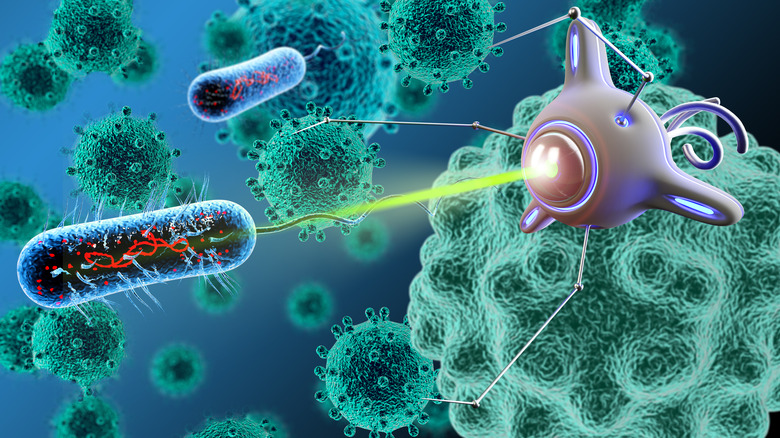How Tiny Robots Can Improve Your Health From Inside The Body
Imagine having a microscopic robot deliver medicine to a specific part of your body or having it check for cancer cells before a tumor develops. Nanobots, which are tiny robots, are capable of performing a variety of tasks and may become a common tool in the health industry. From diagnosis to treatment, nanobots may improve your health by being inside your body, but this technology comes with risks.
How Nanobots Can Help
How Nanobots Can Help
Nanobots may become a crucial part of medical robotics. By going inside a person's body, they can deliver drugs or perform surgery. They can also eliminate the need for invasive procedures that require cutting the skin. For example, a person could swallow the bots or get an injection with them. Then, they could travel to a specific part of the body and perform tasks. This may include diagnosing diseases, repairing tissues and removing damaged cells. Doctors may be able to attach sensors or tools to these robots to carry out specific tests inside your body.
Research on Nanobots
Research on Nanobots
For several years, scientists have explored different ways nanobots could work in health care. Researchers from the University of California have already looked at potential medical uses for nanobots by studying them in mice. They used polymer tubes about 20 micrometers in length with a coating of zinc. Then, they implanted these tubes in the guts of mice. The zinc coating reacted with their stomach acid to make hydrogen bubbles, which helped the tubes move closer to the lining of the stomach. Once they reached the lining, they attached to it. Researchers discovered that these tiny robots are capable of delivering treatment to a specific location by traveling inside the mice.
Risks and Consequences of Using Nanobots
Risks and Consequences of Using Nanobots
Although nanobots have many potential uses in health care, there are also risks associated with them. One of the main concerns is what happens to the tiny robots after they fix your heart or put medicine inside your cells. How will your body eliminate them safely? Researchers have suggested that some bots can leave the body through the usual waste disposal mechanisms by traveling through the gut. Although this may work for swallowed nanobots that travel to the stomach, how will people get rid of robots inside their blood, brain or other organs? Scientists have suggested that these bots may need to have dissolvable materials that do not affect the health of the patient.
Other concerns about nanobots include the human body rejecting the tiny machines and launching an immune response. It is also possible for people to have allergic reactions to some of the materials used in the bots' construction. Moreover, there is the potential for misuse of this technology. A nanobot programmed to repair a cell with microscopic tools may use the same tools to cause deliberate damage if the programming changes. Nanobots may deliver life-saving medicine or a hidden poison. The technology is promising, but it is also important to pay attention to the risks.
Cite This Article
MLA
Bandoim, Lana. "How Tiny Robots Can Improve Your Health From Inside The Body" sciencing.com, https://www.sciencing.com/how-tiny-robots-can-improve-your-health-from-inside-the-body-13711516/. 25 April 2018.
APA
Bandoim, Lana. (2018, April 25). How Tiny Robots Can Improve Your Health From Inside The Body. sciencing.com. Retrieved from https://www.sciencing.com/how-tiny-robots-can-improve-your-health-from-inside-the-body-13711516/
Chicago
Bandoim, Lana. How Tiny Robots Can Improve Your Health From Inside The Body last modified March 24, 2022. https://www.sciencing.com/how-tiny-robots-can-improve-your-health-from-inside-the-body-13711516/
